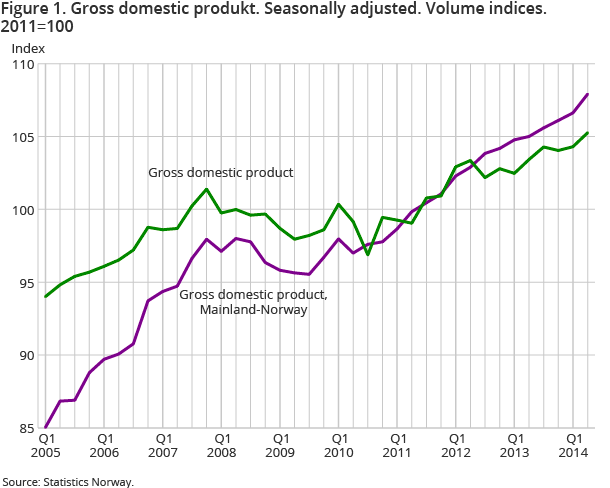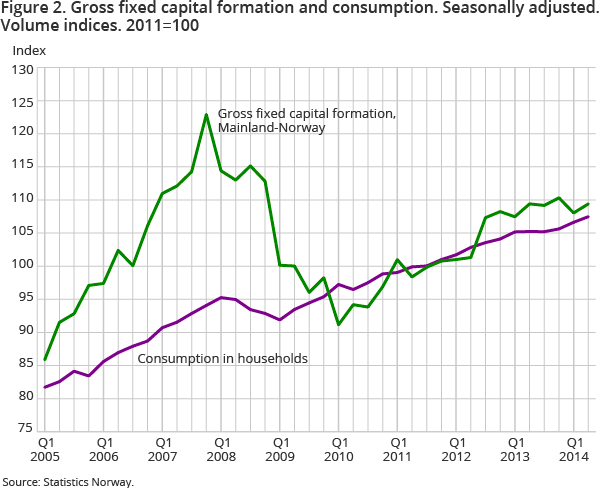Content
Published:
This is an archived release.
Marked growth in Mainland GDP
According to preliminary seasonally-adjusted volume figures, Mainland Norway’s gross domestic product (GDP) grew 1.2 per cent from the 1st quarter to the 2nd quarter this year. Higher production of electricity has in isolation contributed to a positive 0.3 percentage points.
| 20131 | 3rd quarter 2013 | 4th quarter 2013 | 1st quarter 2014 | 2nd quarter 2014 | |
|---|---|---|---|---|---|
| 12013 are preliminary. | |||||
| Gross domestic product | 0.6 | 0.8 | -0.2 | 0.2 | 0.9 |
| Gross domestic product Mainland Norway | 2.0 | 0.6 | 0.5 | 0.5 | 1.2 |
| Petroleum activities and ocean transport | -3.5 | 1.7 | -2.5 | -0.6 | 0.0 |
| Final domestic use of goods and services | 3.2 | 1.4 | 0.6 | -0.7 | 1.6 |
| Final consumption expenditure of households and NPISH | 2.1 | 0.0 | 0.4 | 0.9 | 0.8 |
| Final consumption expenditure of general government | 1.8 | 0.3 | 0.7 | 0.7 | 0.6 |
| Gross fixed capital formation (GFCF) | 8.4 | 1.4 | -0.4 | -3.1 | 1.4 |
| Total exports | -3.3 | 1.5 | -2.3 | 0.4 | -0.6 |
| Total imports | 2.9 | 3.4 | -0.4 | -2.4 | 0.9 |
| Employed persons | 1.2 | 0.4 | 0.3 | 0.2 | 0.3 |
| Total hours worked | 0.6 | 0.5 | 0.4 | 0.4 | 0.6 |


Value added in petroleum activities and ocean transport was unchanged in the 2nd quarter, and total GDP was up 0.9 per cent.
Strong growth in production of goods
Gross value in manufacturing increased by 2.5 per cent in the 2nd quarter, continuing the growth in the 1st quarter. Almost half of the increase in manufacturing was due to increased activity in the food industry, after a small decline in the two previous quarters. Other than that, building of ships, oil platforms and modules, as well as machinery and other equipment grew significantly in the first half of 2014.
Other goods-producing industries grew significantly in the 2nd quarter. This includes a strong increase in production and distribution of electricity, construction and fishing and aquaculture.
Moderate growth in service industries
The activity in general government was up 0.5 per cent, which is the same as in the last two quarters. Service activities grew by 0.4 per cent after increasing 0.2 per cent in the last quarter.
Steady growth in consumption
Household final consumption expenditures increased by 0.8 per cent, after an increase of 0.9 per cent in the 1st quarter. Household consumption of goods grew 1.0 per cent. In particular, food and clothes contributed to the growth. A fall in purchases of vehicles dampened the increase. This fall, however, comes after a strong growth in car purchases in the 1st quarter. The stable increase in consumption of services continued in the 2nd quarter, and was up 0.6 per cent.
Stagnation in petroleum-related investments
The high increase in petroleum-related investments ended in the 3rd quarter of 2013 and fell for two quarters. The petroleum investments remained unchanged from the 1st quarter to the 2nd quarter of 2014. The gross fixed capital formation (GFCF) in petroleum-related industries in the 1st quarter of 2014 has been revised down by approximately NOK 2 billion since the last publication of quarterly national accounts.
Increased investments in general government contributed to the growth in GFCF in Mainland Norway . Investments in manufacturing, however, fell in the 2nd quarter. Household investments in dwelling grew slightly, after a decrease in the last two quarters.
Increased exports of traditional goods
A fall in exports of crude oil contributed to a decrease in exports of goods and services of 0.6 per cent in the 2nd quarter. However, exports of traditional goods increased 3.5 per cent.
Higher employment growth
Employment grew by 0.3 per cent in the 2nd quarter, which is a slightly higher growth than in the previous quarter. Total hours were up 0.6 per cent.
Revisions of previous quarters
When compiling figures for the 2nd quarter this year, revisions were made in the 1st quarter due to the incorporation of new information. The picture of the gross domestic product for Norway and Mainland Norway is the same as in the last publication. For an overview of revisions in the main aggregates, please see Table 48.
Concepts and definitions in National AccountsOpen and readClose
For more information about definitions of the main concepts, variables and classifications in national accounts, see About the statistics, definitions.
How the figures are calculatedOpen and readClose
Four quarters in the Quarterly National Accounts (QNA) are preliminary annual figures until the Annual National Accounts (ANA) for year t are published in November in year t+2 and incorporated as a new base year in the QNA. Hence, 2011 is the base year in QNA when publishing data in May 2014.
In both ANA and QNA, the figures stripped of movements in prices are referred to as volume changes, or fixed price estimates in QNA, and this is done to identify the underlying cyclical pattern of the economy.
Note that in the time series in volume, the figures from the base year and onwards are fixed price figures, while data prior to the base year are chained volume figures. This means that additivity in volume is lost prior to the base year.
Planned changes in the national accounts statisticsOpen and readClose
New revised figures for national accounts and related statistics will be published in November and December 2014. Statistics Norway complies with international guidelines in its preparation of national accounts and statistics on foreign affairs. New international guidelines have now been issued for these statistics. Statistics Norway is currently in the process of implementing the changes, in addition to new source data for some of the statistics.
Contact
-
Pål Sletten
E-mail: pal.sletten@ssb.no
tel.: (+47) 99 29 06 84
-
Ingunn Sagelvmo
E-mail: ingunn.sagelvmo@ssb.no
tel.: (+47) 40 90 26 32
-
Pia Tønjum
E-mail: pia.tonjum@ssb.no
tel.: (+47) 48 99 12 07
-
Kristian Gimming
E-mail: kristian.gimming@ssb.no
tel.: (+47) 91 88 39 06
